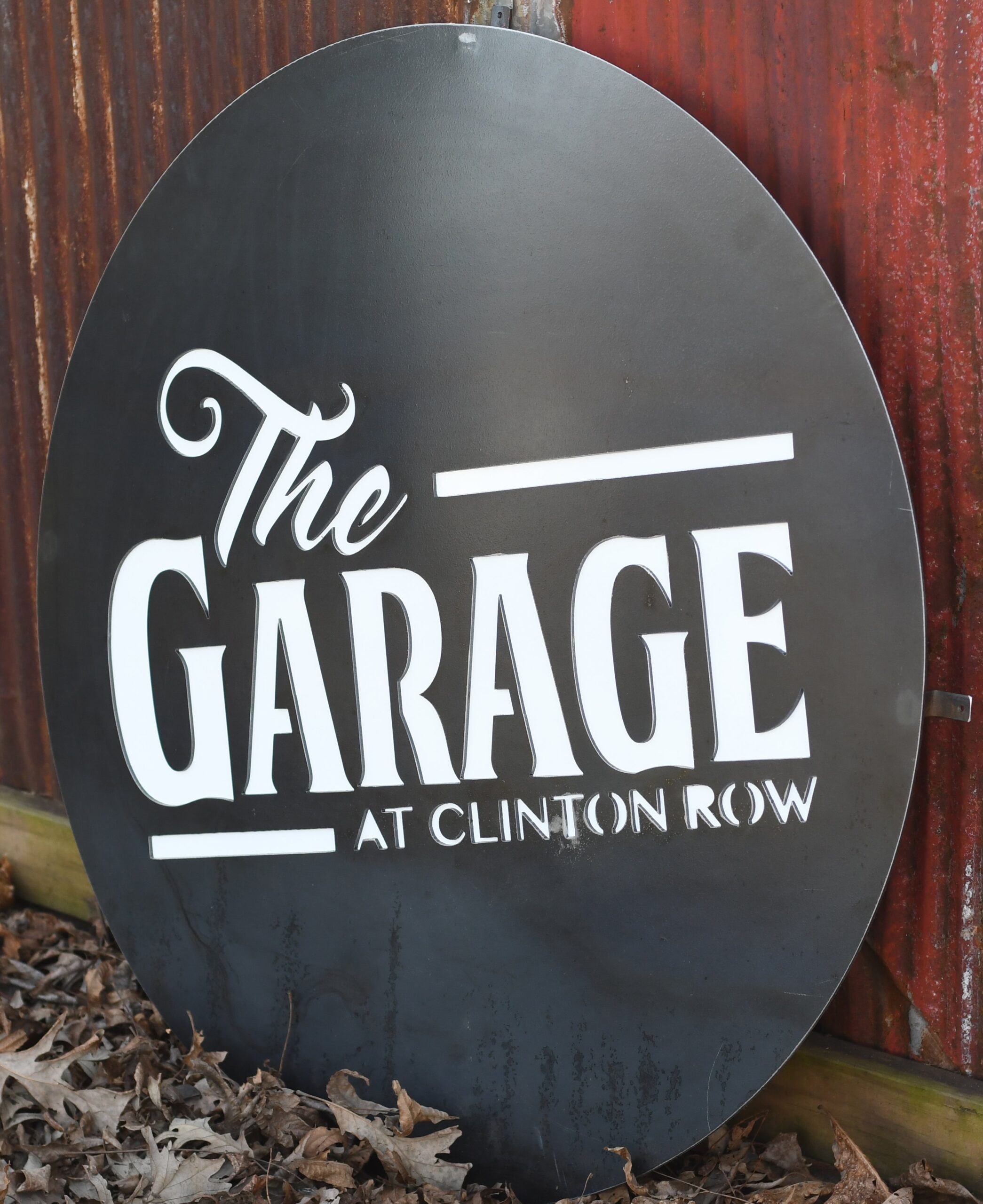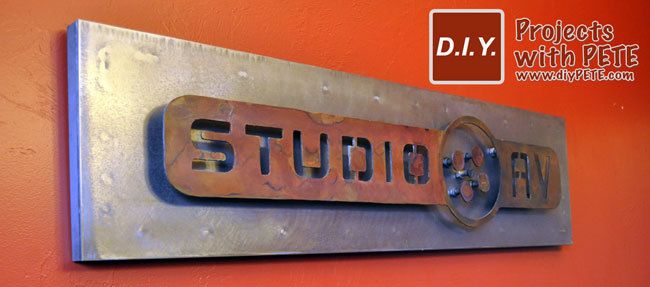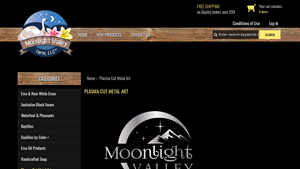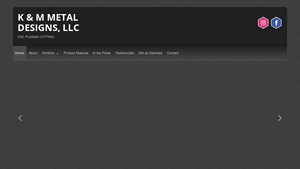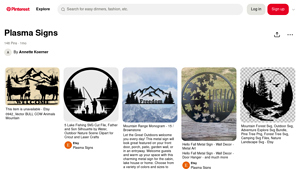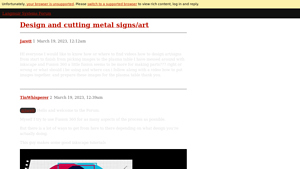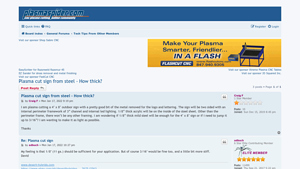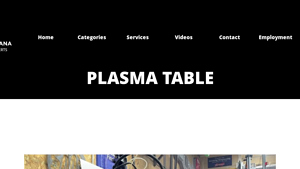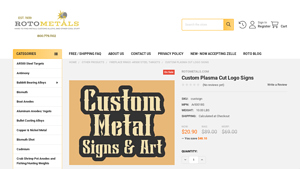Plasma Cutting Signs Guide: Type, Cost, Top List…
Introduction: Navigating the Global Market for plasma cutting signs
In an increasingly interconnected world, sourcing high-quality plasma cutting signs can present unique challenges for international B2B buyers. Whether you are a retailer in Brazil looking to enhance your store’s visibility or an industrial supplier in Vietnam seeking durable signage for your operations, understanding the nuances of the global market is essential. This comprehensive guide will delve into various types of plasma cutting signs, their applications across different industries, and the critical factors to consider when vetting suppliers.
Navigating the complexities of international procurement, especially in regions like Africa, South America, the Middle East, and Europe, requires insight into cost structures, material quality, and production standards. Buyers will learn how to identify reputable manufacturers, assess pricing models, and ensure compliance with regional regulations. Moreover, this guide will provide actionable tips on leveraging local trends and preferences to create signage that resonates with target audiences.
By empowering B2B buyers with the knowledge and tools necessary for informed purchasing decisions, this guide aims to streamline the sourcing process and enhance the overall value derived from plasma cutting signs. From custom designs that reflect brand identity to robust industrial applications, understanding the global landscape of plasma cutting signs is crucial for achieving competitive advantages in today’s marketplace.
Understanding plasma cutting signs Types and Variations
| Type Name | Key Distinguishing Features | Primary B2B Applications | Brief Pros & Cons for Buyers |
|---|---|---|---|
| Custom Metal Signs | Tailored designs, various sizes, and finishes available | Branding, wayfinding, and promotional signage | Pros: Personalized, enhances brand visibility. Cons: Longer lead times for custom orders. |
| Decorative Art Signs | Artistic designs often featuring intricate patterns or themes | Home decor, landscaping, and gifting | Pros: Unique appeal, can enhance aesthetics. Cons: May not be suitable for all business settings. |
| Industrial Safety Signs | Standardized symbols and text for safety compliance | Factories, warehouses, and construction sites | Pros: Ensures compliance, enhances safety awareness. Cons: Limited customization options. |
| Address and Directional Signs | Clear identification of locations, often customized with logos | Real estate, retail, and event management | Pros: Improves navigation, can be branded. Cons: Size and material limitations may apply. |
| Seasonal and Thematic Signs | Signs tailored for specific occasions or seasons | Retail promotions, seasonal events | Pros: Engages customers, timely promotions. Cons: Limited use outside of specific seasons. |
What are Custom Metal Signs and When Should Businesses Consider Them?
Custom metal signs are highly versatile and can be tailored to fit a company’s branding needs. These signs can include logos, slogans, or any specific design elements that resonate with a target audience. B2B buyers should consider these when looking to enhance brand visibility or create a unique identity in a competitive market. The primary considerations include design complexity, material choice, and the time required for production, as custom orders typically have longer lead times.
How Do Decorative Art Signs Enhance Business Environments?
Decorative art signs are designed with an artistic flair, making them suitable for businesses that wish to create a visually appealing environment. These signs can feature intricate designs that resonate with a specific theme or aesthetic. They are often used in hospitality, retail, and personal spaces. B2B buyers should consider the context in which these signs will be displayed, as their unique appeal can enhance customer experience but may not fit all corporate environments.
Why are Industrial Safety Signs Essential for Compliance?
Industrial safety signs are crucial for ensuring compliance with safety regulations in workplaces like factories and construction sites. These signs typically feature standardized symbols and text to convey critical safety information. B2B buyers should prioritize these signs to enhance workplace safety and avoid potential legal liabilities. While customization options may be limited, the primary benefit lies in their effectiveness in communicating safety protocols clearly and efficiently.
How Do Address and Directional Signs Improve Navigation?
Address and directional signs are essential for guiding customers and visitors to specific locations, especially in retail and real estate sectors. These signs can be customized with logos and branding, providing a dual function of navigation and promotion. B2B buyers should consider factors such as size, visibility, and material when purchasing these signs, as they play a significant role in customer experience. Properly designed directional signage can lead to increased foot traffic and customer satisfaction.
What Role Do Seasonal and Thematic Signs Play in Marketing Strategies?
Seasonal and thematic signs are tailored for specific occasions, offering businesses the opportunity to engage customers with timely promotions. These signs can be effectively used in retail environments to highlight sales or events. B2B buyers should assess the relevance of seasonal promotions to their business strategy, as these signs can drive customer engagement and sales. However, the limited use outside of specific seasons may lead to lower long-term value compared to more permanent signage solutions.
Key Industrial Applications of plasma cutting signs
| Industry/Sector | Specific Application of Plasma Cutting Signs | Value/Benefit for the Business | Key Sourcing Considerations for this Application |
|---|---|---|---|
| Manufacturing | Safety and Instructional Signage | Enhances workplace safety and compliance with regulations | Material durability, weather resistance, and customization options |
| Retail and Hospitality | Branding and Promotional Displays | Increases brand visibility and customer engagement | Design flexibility, material choices, and shipping logistics |
| Construction and Real Estate | Project Signage and Directional Signage | Improves project management and visitor navigation | Size specifications, local regulations, and installation support |
| Agriculture and Farming | Farm Identification and Safety Signs | Promotes safety and property identification | Resistance to environmental factors and customization capabilities |
| Transportation and Logistics | Wayfinding and Informational Signs | Streamlines operations and enhances user experience | Reflective materials, size requirements, and durability for outdoor use |
How is Plasma Cutting Used in Manufacturing for Safety Signage?
In the manufacturing sector, plasma cutting signs are extensively used for safety and instructional signage. These signs are vital in communicating safety protocols, hazard warnings, and operational instructions to employees. By utilizing durable materials resistant to wear and environmental conditions, companies can ensure compliance with safety regulations while minimizing the risk of workplace accidents. International buyers should focus on sourcing signs that meet local regulatory standards and can withstand specific industrial conditions.
What Role do Plasma Cutting Signs Play in Retail and Hospitality Branding?
Plasma cutting signs are essential for branding and promotional displays in the retail and hospitality sectors. Custom-designed signs enhance brand visibility and attract customers, contributing to a memorable shopping or dining experience. These signs can be tailored in various shapes and sizes, allowing businesses to create unique visual identities. When sourcing these products, buyers should consider design flexibility, the ability to withstand outdoor elements, and shipping logistics, especially for international transactions.
How are Plasma Cutting Signs Utilized in Construction and Real Estate?
In construction and real estate, plasma cutting signs serve critical functions such as project signage and directional signage. These signs help manage projects by providing essential information about ongoing work and guiding visitors effectively. Sourcing considerations include compliance with local regulations regarding sign size and installation, as well as ensuring that materials can endure outdoor conditions. Customization options are also important for branding purposes on construction sites.
What Benefits Do Plasma Cutting Signs Offer to Agriculture and Farming?
For the agriculture sector, plasma cutting signs are invaluable for farm identification and safety signage. These signs help define property boundaries and communicate important safety information to visitors and workers. The signs must be durable and resistant to harsh weather conditions, ensuring longevity in outdoor settings. Buyers should prioritize sourcing materials that can withstand environmental factors and offer customization options for specific farm branding needs.
How Do Plasma Cutting Signs Enhance Transportation and Logistics Operations?
In transportation and logistics, plasma cutting signs are used for wayfinding and informational purposes. These signs streamline operations by providing clear directions and important information to staff and visitors, thus improving overall efficiency. When sourcing these signs, businesses should look for reflective materials for visibility, size specifications that fit their operational needs, and durability for outdoor use. Understanding these factors is crucial for international buyers in ensuring compliance with local standards and enhancing user experience.
3 Common User Pain Points for ‘plasma cutting signs’ & Their Solutions
Scenario 1: Difficulty in Customization for Unique Branding
The Problem: B2B buyers often struggle to find plasma cutting signs that effectively represent their brand identity. Many businesses require unique designs that resonate with their target audience, yet they frequently encounter limitations with pre-made options. This lack of customization can lead to a mismatch between the signage and the company’s branding, impacting visibility and customer engagement.
The Solution: To address this challenge, buyers should prioritize suppliers that offer robust customization services. When sourcing plasma cutting signs, inquire about the design process and the available materials. For instance, companies like K & M Metal Designs provide a large library of clipart and are open to customer-supplied images, allowing for tailored designs. Buyers should also request samples of previous custom work to ensure the quality meets their expectations. Engaging in a collaborative design process will help ensure that the final product aligns with the brand’s identity and effectively communicates its message.
Scenario 2: Concerns About Material Quality and Durability
The Problem: Another common pain point is the uncertainty surrounding the material quality and durability of plasma cutting signs. B2B buyers often worry that lower-quality materials may lead to signs that degrade quickly, especially in outdoor settings. This concern is particularly relevant for businesses in regions with harsh weather conditions, as signs made from inferior materials can result in additional costs for replacements and maintenance.
The Solution: To mitigate these concerns, buyers should focus on suppliers that use high-quality materials designed for longevity. For example, sourcing signs made from 100% American-made steel can provide assurance of durability. It’s also beneficial to discuss the finishing options, such as powder coating or painting, which can enhance weather resistance. Requesting certifications or product specifications from suppliers can further validate material quality. Additionally, buyers should consider discussing warranties or guarantees, which can serve as a safety net against premature wear and tear.
Scenario 3: Complications in Shipping and Delivery Times
The Problem: Timely delivery is critical for businesses, especially when plasma cutting signs are needed for specific events or marketing campaigns. B2B buyers often encounter issues with shipping delays, particularly when dealing with international suppliers. These delays can result in missed deadlines, which may negatively impact brand visibility and customer outreach efforts.
The Solution: To combat shipping and delivery challenges, buyers should establish clear communication with suppliers regarding their timelines and expectations. It’s advisable to work with companies that have a proven track record of reliable shipping practices. For instance, selecting suppliers who offer local pickup options can eliminate shipping delays altogether. Additionally, buyers should inquire about expedited shipping services and assess the potential for tracking shipments. By thoroughly discussing lead times and any potential bottlenecks before placing an order, businesses can better manage their project timelines and ensure that their plasma cutting signs arrive when needed.
Strategic Material Selection Guide for plasma cutting signs
What Are the Key Materials for Plasma Cutting Signs?
When selecting materials for plasma cutting signs, it is essential to consider factors such as durability, cost, and application suitability. Below, we analyze four common materials used in the industry, focusing on their properties, advantages, disadvantages, and considerations for international B2B buyers.
How Does Mild Steel Perform in Plasma Cutting Signage?
Mild steel is one of the most commonly used materials for plasma cutting signs due to its excellent machinability and cost-effectiveness. It typically has a temperature rating of up to 1,500°F and offers good weldability, making it suitable for various applications.
Pros:
– Durability: Mild steel is robust and can withstand outdoor conditions when properly coated.
– Cost: Generally low-cost compared to other metals, making it an economical choice for large orders.
– Manufacturing Complexity: Easy to cut and shape, allowing for intricate designs.
Cons:
– Corrosion Resistance: Prone to rust if not treated with a protective coating.
– Weight: Heavier than some alternatives, which may affect shipping costs.
Impact on Application: Mild steel is compatible with various finishes, including paint and powder coating, enhancing its aesthetic appeal.
Considerations for International Buyers: Buyers from regions like Africa and South America should ensure compliance with local standards for metal signage, such as ASTM or DIN, to avoid issues with quality and durability.
What Advantages Does Aluminum Offer for Plasma Cutting Signs?
Aluminum is gaining popularity for plasma cutting signs due to its lightweight nature and resistance to corrosion. It typically has a temperature rating of around 1,200°F.
Pros:
– Lightweight: Easier to handle and install, reducing shipping costs.
– Corrosion Resistance: Naturally resistant to rust, making it ideal for outdoor signage.
– Finishing Options: Can be anodized or painted for aesthetic purposes.
Cons:
– Cost: Generally more expensive than mild steel, which may impact budget considerations.
– Strength: Not as strong as mild steel, requiring careful design to ensure structural integrity.
Impact on Application: Aluminum is suitable for applications where weight is a concern, such as hanging signs or portable displays.
Considerations for International Buyers: Buyers should be aware of specific aluminum grades (e.g., 5052 or 6061) that meet local standards, particularly in Europe and the Middle East.
How Does Stainless Steel Compare in the Context of Plasma Cutting Signs?
Stainless steel is known for its high corrosion resistance and aesthetic appeal, making it an excellent choice for premium signage. It can withstand temperatures up to 1,800°F.
Pros:
– Durability: Highly resistant to corrosion and tarnishing, ideal for long-lasting outdoor signs.
– Aesthetic Appeal: Offers a modern and sleek look, enhancing brand image.
Cons:
– Cost: Higher than both mild and aluminum, which may not be suitable for all budgets.
– Manufacturing Complexity: More challenging to cut and weld, requiring specialized equipment.
Impact on Application: Stainless steel is often used for high-end signage, where appearance and longevity are critical.
Considerations for International Buyers: Compliance with international standards like JIS or ASTM is crucial for ensuring quality, especially in regions with strict regulations.
What Role Does Acrylic Play in Plasma Cutting Signage?
Acrylic is often used as a backing material or for illuminated signs due to its transparency and lightweight properties. It can withstand temperatures up to 180°F.
Pros:
– Lightweight: Easy to handle and transport, reducing overall costs.
– Versatility: Can be easily colored or illuminated, enhancing design options.
Cons:
– Durability: Less durable than metals, susceptible to scratching and UV damage.
– Temperature Sensitivity: Not suitable for high-temperature applications.
Impact on Application: Acrylic is ideal for indoor signage or as part of a layered sign design.
Considerations for International Buyers: Buyers should verify that acrylic meets local safety and environmental standards, especially in regions with strict regulations.
Summary of Material Selection for Plasma Cutting Signs
| Material | Typical Use Case for plasma cutting signs | Key Advantage | Key Disadvantage/Limitation | Relative Cost (Low/Med/High) |
|---|---|---|---|---|
| Mild Steel | Outdoor signage, large format designs | Cost-effective and durable | Prone to rust without coating | Low |
| Aluminum | Lightweight signs, portable displays | Corrosion resistant, lightweight | Higher cost than mild steel | Med |
| Stainless Steel | Premium outdoor signage, high-end applications | Highly durable and aesthetically pleasing | Expensive and difficult to manufacture | High |
| Acrylic | Indoor signage, illuminated signs | Lightweight and versatile | Less durable, temperature sensitive | Low |
This guide serves as a comprehensive overview for B2B buyers looking to make informed decisions regarding material selection for plasma cutting signs, taking into account various factors that influence performance and compliance in different regions.
In-depth Look: Manufacturing Processes and Quality Assurance for plasma cutting signs
What Are the Key Stages in the Manufacturing Process of Plasma Cutting Signs?
The manufacturing of plasma cutting signs involves several critical stages that ensure the production of high-quality products. Understanding these stages can help B2B buyers assess the capabilities and reliability of their suppliers.
Material Preparation: How Is the Right Steel Selected?
The first step in the manufacturing process is selecting the appropriate material. Most plasma cutting signs are made from steel, which can be mild steel, stainless steel, or aluminum. The choice of material depends on the intended use of the sign, such as outdoor durability or aesthetic appeal.
Once the material is selected, it undergoes preparation, which includes cutting it to size and removing any surface imperfections. This step is crucial as it affects the quality of the final product. Suppliers should be able to demonstrate their material sourcing practices, ensuring that they use high-quality, certified materials.
Forming: What Techniques Are Used in Plasma Cutting?
After preparation, the material is subjected to plasma cutting, a process that uses a high-velocity jet of ionized gas to cut through metal. This technique allows for intricate designs and precise cuts, which are essential for creating detailed signs.
CNC (Computer Numerical Control) technology is often employed to enhance precision and repeatability. This automated process reduces human error and increases production efficiency, which is particularly beneficial for large orders or custom designs. B2B buyers should inquire about the type of CNC equipment used, as well as the training and expertise of the operators.
Assembly: How Are Plasma Cutting Signs Constructed?
Once the individual components are cut, they are assembled into the final product. This may involve welding, riveting, or bolting pieces together, depending on the design and intended use of the sign. For illuminated signs, additional steps may be required, such as incorporating LED lighting or electrical components.
Quality of assembly is paramount, as it influences the sign’s durability and performance. B2B buyers should ensure that their suppliers have skilled technicians who adhere to best practices in assembly. It is advisable to request information about the assembly process and any quality checks performed at this stage.
Finishing: What Finishing Techniques Ensure Longevity?
The final stage in the manufacturing process is finishing, which may include painting, powder coating, or applying protective coatings to enhance durability and aesthetic appeal. Powder coating is particularly popular as it provides a hard, protective layer that resists chipping, scratching, and fading.
Finishing techniques not only improve the visual appearance of the signs but also extend their lifespan, making them suitable for outdoor use. B2B buyers should seek suppliers who can provide details on their finishing processes and the types of coatings used, as these can vary significantly in quality and performance.
What Quality Assurance Measures Are Essential for Plasma Cutting Signs?
Quality assurance (QA) is a critical aspect of the manufacturing process for plasma cutting signs. It ensures that products meet specified standards and perform reliably throughout their intended lifespan.
Which International Standards Should B2B Buyers Be Aware Of?
For plasma cutting signs, adherence to international standards such as ISO 9001 is essential. ISO 9001 outlines the requirements for a quality management system (QMS), ensuring consistent quality in products and services. Suppliers that are ISO certified demonstrate a commitment to quality and continuous improvement.
In addition to ISO standards, industry-specific certifications such as CE (Conformité Européenne) for products sold in Europe or API (American Petroleum Institute) for signs used in industrial applications may be relevant. Understanding these certifications can help B2B buyers evaluate the compliance and quality of the products they intend to purchase.
What Are the Key Quality Control Checkpoints?
Quality control (QC) should occur at multiple checkpoints throughout the manufacturing process:
-
Incoming Quality Control (IQC): This initial inspection ensures that raw materials meet specified standards before production begins. B2B buyers should verify that their suppliers conduct thorough IQC, including material certifications.
-
In-Process Quality Control (IPQC): During manufacturing, ongoing inspections should be performed to monitor processes and ensure compliance with quality standards. This includes checking the accuracy of CNC cuts and the quality of assembly.
-
Final Quality Control (FQC): After manufacturing, a final inspection assesses the finished product against quality standards. This step may involve functional testing, visual inspections, and dimensional checks. B2B buyers should ask suppliers about their FQC procedures and any documentation provided, such as inspection reports.
How Can B2B Buyers Verify Supplier Quality Control Practices?
B2B buyers have several options to verify the quality control practices of their suppliers:
-
Audits: Conducting on-site audits of potential suppliers can provide insights into their manufacturing processes, quality control measures, and overall operational efficiency. This step is particularly important for international buyers who may not be familiar with local manufacturing practices.
-
Reports: Requesting quality control reports, including IQC, IPQC, and FQC documentation, can help buyers understand the supplier’s commitment to quality. These reports should detail any non-conformities and corrective actions taken.
-
Third-Party Inspections: Engaging third-party inspection services can offer an unbiased assessment of the supplier’s quality control processes. This is especially useful for larger orders or when dealing with new suppliers.
What Are the Unique Quality Control Considerations for International B2B Buyers?
International B2B buyers must be aware of specific nuances related to quality control in their regions. For instance, regulations and standards may vary significantly between Africa, South America, the Middle East, and Europe. Understanding these regional differences can help buyers ensure compliance and avoid costly misunderstandings.
Additionally, language barriers and cultural differences may impact communication regarding quality expectations. Establishing clear lines of communication and expectations upfront can mitigate these challenges.
In conclusion, a thorough understanding of the manufacturing processes and quality assurance measures for plasma cutting signs is crucial for B2B buyers. By focusing on material selection, production techniques, and stringent quality control practices, buyers can ensure they partner with reliable suppliers who deliver high-quality products tailored to their needs.
Practical Sourcing Guide: A Step-by-Step Checklist for ‘plasma cutting signs’
To assist B2B buyers in procuring high-quality plasma cutting signs, this guide provides a comprehensive checklist. By following these steps, you can ensure that your sourcing process is efficient and effective, ultimately leading to a successful purchase.
Step 1: Define Your Technical Specifications
Before reaching out to suppliers, clearly outline your technical requirements for the plasma cutting signs. Consider factors such as size, thickness, material type (e.g., steel or aluminum), and finish (e.g., painted or powder-coated). This step is crucial because it helps potential suppliers understand your needs and tailor their offerings accordingly.
- Size and Thickness: Determine the dimensions of the sign and the material thickness, which will impact durability and visibility.
- Material Options: Assess whether you need weather-resistant materials suitable for outdoor use, particularly if the signs will be exposed to the elements.
Step 2: Research Potential Suppliers
Conduct thorough research to identify suppliers who specialize in plasma cutting signs. Look for companies with a strong reputation in the industry and positive reviews from previous customers. This step is vital for ensuring that you partner with reliable manufacturers who can deliver quality products.
- Online Directories: Utilize B2B marketplaces and directories to find suppliers with experience in your specific requirements.
- Local vs. International: Consider the pros and cons of sourcing locally versus internationally, including shipping costs and lead times.
Step 3: Evaluate Supplier Credentials
Once you have a shortlist of suppliers, verify their credentials and capabilities. This includes checking for certifications, quality control processes, and experience in producing similar products. A supplier’s credentials can provide insight into their reliability and product quality.
- Certifications: Look for ISO certifications or industry-specific standards that indicate a commitment to quality.
- Experience: Request case studies or examples of previous work that align with your project requirements.
Step 4: Request Samples
Before finalizing your order, request samples of the plasma cutting signs. This allows you to assess the quality of the materials and workmanship firsthand. Evaluating samples is essential to ensure that the final product meets your expectations.
- Quality Check: Examine the finish, cut precision, and overall aesthetics of the samples.
- Customization Options: Inquire if the supplier can accommodate custom designs or modifications based on your specifications.
Step 5: Discuss Lead Times and Shipping Options
Understanding the lead times and shipping options is crucial for planning your project timeline. Discuss these aspects with potential suppliers to ensure they can meet your deadlines.
- Production Time: Ask about the typical turnaround time for orders of your size and complexity.
- Shipping Logistics: Evaluate shipping methods, costs, and any potential delays, especially for international orders.
Step 6: Negotiate Terms and Pricing
Once you are satisfied with a supplier, enter into negotiations regarding pricing and terms. Clear agreements on payment schedules, warranties, and return policies can help mitigate risks associated with your purchase.
- Volume Discounts: Inquire about discounts for larger orders, which can reduce your overall costs.
- Payment Terms: Establish clear payment terms to avoid misunderstandings later in the transaction.
Step 7: Finalize the Order and Confirm Details
After negotiations, finalize your order by confirming all details in writing. This should include specifications, pricing, lead times, and any agreed-upon terms. A well-documented order helps prevent disputes and ensures accountability from both parties.
By following this checklist, B2B buyers can navigate the sourcing process for plasma cutting signs with confidence, ensuring they receive quality products that meet their needs.
Comprehensive Cost and Pricing Analysis for plasma cutting signs Sourcing
What Are the Key Cost Components in Plasma Cutting Signs?
When sourcing plasma cutting signs, understanding the cost structure is crucial for B2B buyers. The primary cost components include:
-
Materials: The choice of metal, such as mild steel or aluminum, significantly impacts pricing. Higher-quality materials often come at a premium, so it’s essential to balance quality with budget constraints. For instance, 1/8″ mild steel is commonly used, but for larger signs requiring durability, 3/16″ may be preferable.
-
Labor: The complexity of the design and the required precision can affect labor costs. Custom designs necessitate skilled labor, which can increase overall expenses. Additionally, labor rates vary by region, influencing the final price for international buyers.
-
Manufacturing Overhead: This encompasses costs related to facility maintenance, equipment depreciation, and utilities. Efficient operations can help keep these costs down, benefiting the buyer.
-
Tooling: Initial investments in cutting tools and CNC machines contribute to tooling costs. Some suppliers may pass these costs onto buyers, especially for custom orders requiring specific tooling.
-
Quality Control (QC): Ensuring that products meet specified standards involves QC processes that incur additional costs. Certifications and quality assurance measures can enhance product value but may also raise the price.
-
Logistics: Shipping costs can vary significantly based on the distance, weight, and delivery method. For international orders, understanding Incoterms is crucial as they dictate responsibility for shipping costs, insurance, and risks.
-
Margin: Suppliers typically add a profit margin to their costs. This can vary widely based on market competition, perceived value, and customer relationship dynamics.
How Do Price Influencers Affect Plasma Cutting Sign Costs?
Several factors can influence the pricing of plasma cutting signs:
-
Volume and Minimum Order Quantity (MOQ): Larger orders often qualify for discounts due to economies of scale. Buyers should consider consolidating orders to maximize savings.
-
Specifications and Customization: Unique designs or specific dimensions can lead to higher costs. Providing clear specifications can help suppliers offer accurate quotes without unexpected charges.
-
Material Choices: The type and thickness of the metal significantly impact pricing. Buyers should assess their needs carefully to select the most cost-effective materials without compromising quality.
-
Quality Certifications: Products certified for specific standards may command higher prices. Buyers in regulated industries should factor these certifications into their purchasing decisions.
-
Supplier Factors: The reputation and reliability of the supplier can affect pricing. Established suppliers may offer better warranties and customer service, justifying higher costs.
-
Incoterms: Understanding shipping terms can help buyers manage costs effectively. Choosing a term that minimizes risk and expense is vital for international transactions.
What Are Some Effective Buyer Tips for Negotiating Plasma Cutting Sign Prices?
Negotiating effectively can lead to significant savings on plasma cutting signs:
-
Research and Benchmarking: Buyers should research market prices and seek multiple quotes to understand the typical cost range. This knowledge empowers them during negotiations.
-
Emphasize Total Cost of Ownership (TCO): Instead of focusing solely on the initial purchase price, consider the TCO, including maintenance, durability, and potential resale value. Highlighting long-term savings can justify a slightly higher upfront investment.
-
Flexibility on Specifications: Being open to alternative materials or design suggestions can lead to cost reductions. Suppliers often have insights into cost-effective solutions that meet buyer needs.
-
Long-Term Relationships: Building relationships with suppliers can lead to better pricing and service over time. Suppliers may be more inclined to offer discounts to repeat customers.
-
Understanding International Pricing Nuances: For buyers in regions like Africa, South America, and the Middle East, currency fluctuations and import duties can impact pricing. Buyers should factor these elements into their budgeting and negotiations.
Conclusion
By understanding the cost components, pricing influencers, and negotiation strategies, B2B buyers can make informed decisions when sourcing plasma cutting signs. Given the complexity of international transactions, particularly for buyers in diverse regions, a thorough approach to cost analysis and relationship management can yield significant advantages. Always remember that prices may vary, and it’s advisable to treat any pricing discussed as indicative rather than fixed.
Alternatives Analysis: Comparing plasma cutting signs With Other Solutions
Exploring Alternatives to Plasma Cutting Signs
In the competitive landscape of metal signage, plasma cutting offers a unique approach to creating intricate designs and durable products. However, businesses must consider various alternatives that may better suit their needs based on performance, cost, and specific applications. This analysis provides a comparative overview of plasma cutting signs against other viable methods, including laser cutting and traditional engraving.
| Comparison Aspect | Plasma Cutting Signs | Laser Cutting Signs | Traditional Engraving |
|---|---|---|---|
| Performance | High precision; fast cutting speeds; suitable for thick materials | Extremely precise; ideal for intricate designs; limited thickness | Good for detailed work on softer materials; slower process |
| Cost | Moderate initial investment; lower operational costs for high volume | Higher initial investment; operational costs vary based on material | Generally lower setup costs; higher labor costs over time |
| Ease of Implementation | Requires skilled operators; setup can be complex | User-friendly; software integration simplifies design | Simple tools required; labor-intensive manual process |
| Maintenance | Requires regular maintenance of equipment; consumables needed | Minimal maintenance; mainly lens and mirror care | Low maintenance; tools need regular sharpening |
| Best Use Case | Large signs, outdoor applications, industrial uses | Fine art, intricate designs, small signs | Personalization, trophies, plaques |
Analyzing Laser Cutting as an Alternative
Laser cutting is a prominent alternative to plasma cutting for creating signs. The technology uses focused laser beams to cut through materials with extreme precision. One of its significant advantages is the ability to produce intricate designs that plasma cutting may struggle with, especially in thin materials. However, the initial investment in laser cutting equipment can be higher, and while operational costs may vary, they tend to be more economical for smaller production runs. Laser cutting is best suited for applications requiring fine detail and precision, such as custom art pieces or detailed signage.
Understanding Traditional Engraving
Traditional engraving remains a viable option, especially for smaller, personalized items like plaques and trophies. This method is often less expensive to set up than plasma or laser cutting, making it accessible for businesses focused on smaller-scale production. However, the process is labor-intensive and can be time-consuming, limiting its efficiency for larger projects. Engraving is typically more suited for softer materials and detailed work where a personal touch is desired. While it lacks the speed and scalability of plasma cutting, its craftsmanship appeals to specific markets.
Conclusion: Choosing the Right Solution for Your Needs
When selecting the right signage solution, B2B buyers must assess their specific requirements, including the type of material, design complexity, volume of production, and budget. Plasma cutting signs are ideal for large-scale projects where durability and speed are critical. In contrast, laser cutting excels in precision and detail, making it suitable for artistic applications. Traditional engraving offers a cost-effective solution for personalized items but may not meet the demands of larger productions. By evaluating these factors, businesses can make informed decisions that align with their operational goals and customer expectations.
Essential Technical Properties and Trade Terminology for plasma cutting signs
What Are the Key Technical Properties of Plasma Cutting Signs?
When considering plasma cutting signs, understanding the essential technical specifications is crucial for making informed purchasing decisions. Here are several critical properties that B2B buyers should be aware of:
1. Material Grade
The material grade is a fundamental aspect of plasma cutting signs. Common materials include mild steel, stainless steel, and aluminum. For instance, mild steel is often used for its cost-effectiveness, while stainless steel offers better corrosion resistance. The choice of material directly impacts the durability and aesthetic appeal of the signs, making it essential to select a grade that aligns with the intended application and environmental conditions.
2. Thickness
The thickness of the metal used in plasma cutting significantly affects the sign’s structural integrity and weight. Typical thicknesses range from 1/8 inch (11 gauge) to 3/16 inch (7 gauge). Thicker materials provide greater rigidity, which is crucial for larger signs or those exposed to harsh weather. However, increased thickness also means added weight and cost, so finding the right balance is key for B2B buyers.
3. Tolerance
Tolerance refers to the permissible variation in the dimensions of the cut sign. For plasma cutting, tolerances can range from ±0.5 mm to ±1.5 mm. Maintaining tight tolerances is important for applications that require precise fitting or alignment, such as signage with intricate designs or those that will be mounted alongside other elements. Understanding the tolerance levels ensures that the signs will meet the specific requirements of the project.
4. Finish Type
The finish type of a plasma-cut sign can greatly influence its appearance and longevity. Common finishes include powder coating and painted options. Powder coating provides a more durable and weather-resistant surface compared to traditional paint, making it ideal for outdoor signs. B2B buyers should consider the intended use and environmental factors when selecting the finish to enhance the sign’s lifespan and visual appeal.
5. Customization Options
Customization plays a vital role in meeting specific client requirements. Many manufacturers offer a range of design options, including size, shape, and logo integration. The ability to customize signs allows businesses to create unique branding opportunities. Understanding the capabilities and limitations of customization can help buyers align their needs with what suppliers can offer.
Which Trade Terms Are Important in the Plasma Cutting Industry?
Familiarity with industry jargon is essential for effective communication and negotiation with suppliers. Here are several key terms to know:
1. OEM (Original Equipment Manufacturer)
OEM refers to companies that produce parts or equipment that may be marketed by another manufacturer. In the context of plasma cutting signs, understanding OEM relationships can help buyers identify reliable suppliers that provide high-quality materials or components.
2. MOQ (Minimum Order Quantity)
MOQ indicates the smallest number of units that a supplier is willing to sell. Knowing the MOQ is crucial for B2B buyers, as it impacts budgeting and inventory management. Suppliers may have different MOQs based on product type, so understanding this term helps in planning purchases effectively.
3. RFQ (Request for Quotation)
An RFQ is a formal request from a buyer to suppliers for pricing on specific products or services. This process is essential for obtaining competitive pricing and evaluating different suppliers. Crafting a clear and detailed RFQ can lead to better responses and more favorable terms.
4. Incoterms (International Commercial Terms)
Incoterms are a set of rules that define the responsibilities of buyers and sellers in international transactions. These terms clarify who bears the risk and costs associated with shipping, delivery, and customs clearance. Familiarity with Incoterms is vital for B2B buyers engaged in cross-border transactions to avoid misunderstandings.
5. Lead Time
Lead time refers to the amount of time it takes from placing an order until the product is delivered. Understanding lead times is critical for planning and ensuring that signage is available when needed, especially for promotional events or project deadlines.
By mastering these technical properties and trade terms, B2B buyers can make more informed decisions, enhance negotiation strategies, and ultimately improve their procurement processes for plasma cutting signs.
Navigating Market Dynamics and Sourcing Trends in the plasma cutting signs Sector
What Are the Key Trends Driving the Plasma Cutting Signs Market?
The plasma cutting signs market is witnessing a significant transformation influenced by various global drivers. Increasing demand for personalized and customized signage solutions is driving B2B buyers to seek suppliers who can deliver unique designs. Advances in technology, particularly in CNC plasma cutting, have enabled manufacturers to produce intricate designs at competitive prices. This trend is particularly relevant for international buyers in regions like Africa, South America, the Middle East, and Europe, where customization can cater to local tastes and cultural nuances.
Moreover, the rise of e-commerce platforms has simplified sourcing for B2B buyers, allowing them to access a broader range of suppliers. Digital tools facilitate efficient communication and streamline order processes, making it easier for businesses to collaborate with manufacturers across borders. Additionally, the integration of automation and AI in production processes is enhancing efficiency, reducing lead times, and improving product quality.
Emerging trends also include the increasing use of eco-friendly materials and finishes in the production of plasma cutting signs. As sustainability becomes a focal point for businesses globally, suppliers that can offer sustainable options are gaining a competitive edge. For buyers in developing regions, leveraging local resources for production not only fosters community growth but also aligns with global sustainability goals.
How Important is Sustainability and Ethical Sourcing in the Plasma Cutting Signs Sector?
Sustainability and ethical sourcing are becoming critical considerations for B2B buyers in the plasma cutting signs sector. The environmental impact of production processes, particularly in metalworking, has prompted businesses to seek suppliers committed to eco-friendly practices. Using recycled metals and sustainable finishes not only reduces waste but also appeals to environmentally conscious consumers.
Ethical supply chains are essential in establishing brand credibility. Buyers are increasingly scrutinizing their suppliers’ practices, favoring those who maintain transparency and adhere to ethical labor standards. Certifications such as ISO 14001 for environmental management and Fair Trade practices can significantly enhance a supplier’s marketability.
Moreover, the demand for ‘green’ materials, such as water-based paints and finishes, is on the rise. B2B buyers who prioritize sustainable sourcing are often rewarded with long-term partnerships and customer loyalty, as consumers become more aware of the environmental implications of their purchases. This alignment with sustainability not only meets regulatory requirements but also positions companies favorably in a competitive market.
What Is the Historical Context of Plasma Cutting Signs in the B2B Landscape?
The evolution of plasma cutting signs dates back to the mid-20th century when plasma cutting technology was first developed for industrial applications. Initially used for heavy-duty metalwork, the technology gradually found its way into artistic and decorative applications, including signage. As the capabilities of plasma cutting improved, so did the complexity and creativity of the designs that could be achieved.
In the late 20th and early 21st centuries, the advent of computer numerical control (CNC) technology revolutionized the plasma cutting process. This innovation allowed for precision cutting and the ability to create intricate designs that appealed to both commercial and residential markets. As a result, plasma cutting signs became a popular choice for businesses seeking distinctive branding solutions.
Today, plasma cutting signs are not only a staple in commercial signage but also in home decor and personalized gifts. The ongoing technological advancements continue to shape the market, making it imperative for B2B buyers to stay informed about the latest developments to ensure they are sourcing the most innovative and relevant products for their needs.
Frequently Asked Questions (FAQs) for B2B Buyers of plasma cutting signs
-
How do I evaluate the quality of plasma cutting signs from suppliers?
To assess the quality of plasma cutting signs, request samples or detailed photos of previous work. Evaluate the finish and precision of the cuts, as well as the durability of materials used, such as steel thickness and coating options. Additionally, inquire about the manufacturing process and any quality assurance measures in place. Reading customer testimonials and reviews can also provide insights into the supplier’s reliability and product quality. -
What is the best material for plasma cutting signs?
The best materials for plasma cutting signs typically include mild steel, stainless steel, and aluminum. Mild steel is cost-effective and versatile, suitable for indoor and outdoor use when properly coated. Stainless steel offers corrosion resistance, making it ideal for harsher environments. Aluminum is lightweight and easy to manipulate, although it may not be as durable as steel. The choice depends on your specific application, aesthetic preferences, and budget. -
How can I customize my plasma cutting sign?
Most suppliers offer customization options, including size, shape, design, and finish. To initiate customization, provide a clear description or a sketch of your desired design. Many suppliers have libraries of clipart or can work from your images. Be sure to ask for a quote and any additional costs associated with customization. Discuss the lead time required for custom orders, as it may vary depending on the complexity of your request. -
What are the typical minimum order quantities (MOQ) for plasma cutting signs?
Minimum order quantities can vary significantly between suppliers. Some may have no MOQ, while others might require a minimum of 10 to 50 pieces, especially for custom designs. When sourcing internationally, consider the MOQ in relation to shipping costs and potential tariffs. It’s advisable to negotiate MOQs with suppliers to find a balance that meets your needs without incurring unnecessary costs. -
What payment terms should I expect when sourcing plasma cutting signs?
Payment terms vary by supplier and may include options like upfront payment, partial payment upon order confirmation, and balance due on delivery. For international transactions, consider payment methods such as wire transfers, letters of credit, or escrow services, which can offer security for both parties. Discuss payment terms upfront to avoid misunderstandings and ensure that they align with your financial processes. -
How do I ensure compliance with international trade regulations when importing plasma cutting signs?
To ensure compliance, familiarize yourself with both your country’s import regulations and those of the supplier’s country. This includes understanding tariffs, duties, and any specific certifications required for metal products. Working with a freight forwarder can help navigate customs regulations and documentation. Ensure that your supplier provides necessary shipping documents, such as a commercial invoice and packing list, to facilitate smooth customs clearance. -
What logistics considerations should I keep in mind when sourcing plasma cutting signs internationally?
When sourcing internationally, consider shipping options, lead times, and costs. Discuss with your supplier about packaging to prevent damage during transit. Understand the logistics of your supply chain, including port of entry, customs clearance, and local delivery. Additionally, factor in potential delays due to customs processing and plan your inventory accordingly to avoid disruptions in your operations. -
How can I vet suppliers of plasma cutting signs effectively?
To vet suppliers, conduct thorough research by reviewing their website, product range, and customer feedback. Request references from other international buyers and inquire about their experience with the supplier. Assess their production capabilities, quality control processes, and lead times. Visiting the supplier’s facility, if feasible, can provide deeper insights into their operations and commitment to quality, enhancing your confidence in the partnership.
Important Disclaimer & Terms of Use
⚠️ Important Disclaimer
The information provided in this guide, including content regarding manufacturers, technical specifications, and market analysis, is for informational and educational purposes only. It does not constitute professional procurement advice, financial advice, or legal advice.
While we have made every effort to ensure the accuracy and timeliness of the information, we are not responsible for any errors, omissions, or outdated information. Market conditions, company details, and technical standards are subject to change.
B2B buyers must conduct their own independent and thorough due diligence before making any purchasing decisions. This includes contacting suppliers directly, verifying certifications, requesting samples, and seeking professional consultation. The risk of relying on any information in this guide is borne solely by the reader.
Top 8 Plasma Cutting Signs Manufacturers & Suppliers List
1. Moonlight Valley Farm – Plasma Cut Metal Art
Domain: moonlightvalleyfarm.com
Registered: 2010 (15 years)
Introduction: Plasma Cut Metal Art products include a variety of signs such as seasonal signs, garden art, household decor, man cave signs, religious signs, and house address numbered signs. All products are made in the USA using 100% American made steel. Custom signs are available upon request. The store offers free shipping on Daylily orders over $99 and local customers can choose ‘STORE PICKUP’ to avoid ship…
2. K & M Metal Designs – Custom Metal Signs and Wall Art
Domain: kmmetaldesigns.com
Registered: 2012 (13 years)
Introduction: K & M Metal Designs, LLC offers custom designed metal signs and wall art, including signage, home decor gifts, personal wall art, and word art. They utilize CNC Plasma cutting technology for both industrial and commercial needs. The company has a large library of clipart for customization and provides free quotes for custom designs. They also handle industrial cutting projects for local companies….
3. Plasma Signs – Mountain Range Monogram
Domain: pinterest.com
Registered: 2009 (16 years)
Introduction: Plasma Signs Mountain Range Monogram – 15 / Brownstone: Metal sign for front door, porch, patio, garden wall, or entryway. Customizable in various colors and sizes. Made from USA 16 gauge cold-rolled steel with a powder coat finish for outdoor durability. Ideal as housewarming gifts. Other products include Hello Fall Metal Sign, Mountain Forest Svg bundle, Forest Wood Name Sign, and personalized D…
4. Langmuir Systems – Plasma Cutting Software Solutions
Domain: forum.langmuirsystems.com
Registered: 2017 (8 years)
Introduction: Design and cutting metal signs/art using plasma tables involves several software tools and processes. Key software mentioned include Inkscape, Fusion 360, Affinity Designer, and SheetCam. The workflow typically involves designing with vector drawing programs, generating G-code files compatible with plasma cutters, and using FireControl to execute the cuts. Tutorials and resources are available on …
5. PlasmaSpider – Illuminated Steel Sign
Domain: plasmaspider.com
Registered: 2008 (17 years)
Introduction: Plasma cut sign from steel, dimensions: 4′ x 8′, two-sided, internal perimeter framework of 3″ channel, internal LED lighting, 1/8″ thick acrylic on the inside of the steel sheet, material options: 1/8″ thick mild steel or 3/16″ thick mild steel, consideration for aluminum as a lighter alternative.
6. Signs of Montana – Plasma Table
7. RotoMetals – Custom Plasma Cut Logo Signs
Domain: rotometals.com
Registered: 2001 (24 years)
Introduction: Product Name: Custom Plasma Cut Logo Signs
SKU: custsign
UPC: Not specified
MPN: Ar50018S
Weight: 10.00 LBS
Shipping: Calculated at Checkout
On Sale: Yes
MSRP: $69.00
Current Price: $20.90
Previous Price: $89.00
Savings: $48.10
Current Stock: Available
Description: Custom plasma cut logo signs made in-house in Cleveland, Ohio. Offers a simple process for custom orders with a 100% satisfaction guar…
8. Etsy – Customizable Plasma Cut Signs
Domain: etsy.com
Registered: 2004 (21 years)
Introduction: Plasma Cut Signs available on Etsy UK include a variety of customizable options such as rustic backlit signs, custom logo cut metal signs, and personalized metal farm signs. Prices range from £6.99 to £221.95, with many items offering free UK delivery. Popular sellers include Signaturel, ThorMetalWallArt, MetalSignia, and LignousLaser, with discounts available on select items. The signs are suitab…
Strategic Sourcing Conclusion and Outlook for plasma cutting signs
In navigating the dynamic landscape of plasma cutting signs, strategic sourcing emerges as a crucial element for international B2B buyers. By aligning with reliable suppliers, businesses can secure high-quality products that not only meet but exceed customer expectations. Emphasizing customization capabilities, diverse product offerings, and competitive pricing will enable companies to cater to regional demands across Africa, South America, the Middle East, and Europe.
As buyers assess their sourcing strategies, understanding the importance of material quality—such as the use of American-made steel—and the potential for localized production can enhance supply chain efficiency and responsiveness. Moreover, leveraging technological advancements in CNC plasma cutting ensures precision and scalability, ultimately driving profitability.
Looking ahead, the market for plasma cutting signs is poised for growth. As consumer trends shift towards personalized and unique signage solutions, now is the time for buyers to evaluate their sourcing options. By engaging with innovative manufacturers and exploring partnerships, businesses can position themselves at the forefront of this evolving market. Embrace the opportunity to enhance your product offerings and meet the diverse needs of your clientele—start your strategic sourcing journey today.
